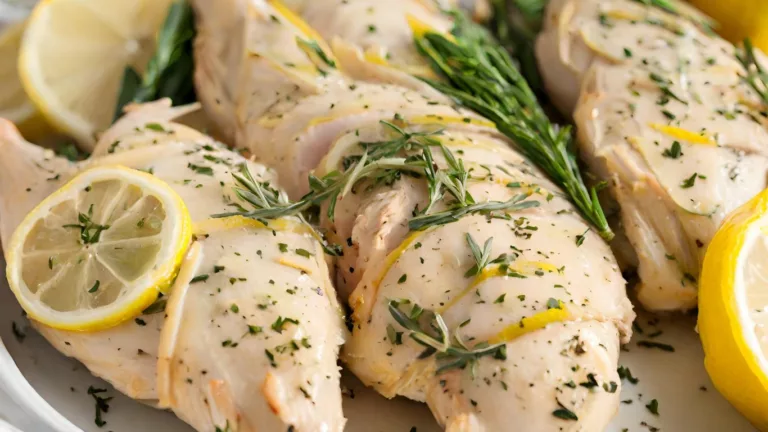How to Prepare GERD-Friendly Fish: Delicious, Healthy and Simple Recipes
Living with GERD (gastroesophageal reflux disease) can be a real challenge, especially when it comes to finding foods that won’t trigger your symptoms. As a medical assistant in a gastroenterology clinic, I’ve seen firsthand how important it is for patients to have access to simple, effective meal options that are both healthy and GERD-friendly. One of the best types of food to include in your diet is fish. It’s lean, packed with protein, and can be incredibly versatile. But, how do you prepare GERD-friendly fish that’s both tasty and safe for your digestive system? Let me walk you through some great options and tips based on my experience.
What Makes Fish GERD-Friendly?
Before we dive into how to prepare fish for GERD, let’s first talk about what makes it a good choice. Fish is typically easy to digest, and many types of fish are low in fat, which is essential for managing GERD symptoms. High-fat foods, especially fried or greasy options, tend to relax the lower esophageal sphincter (LES), which allows stomach acid to flow back up into the esophagus—leading to heartburn and discomfort. Fish, however, is generally much easier on the stomach. But not all fish are created equal, so there are a few things you’ll need to keep in mind when preparing it.

Choosing the Right Fish for GERD
When it comes to selecting fish for GERD, it’s important to choose varieties that are lower in fat and prepared in a way that minimizes the risk of triggering acid reflux. Opting for white fish like cod, haddock, or tilapia is usually a safe bet. These fish tend to have less fat compared to oily fish like salmon, mackerel, or sardines. While those oily fish are excellent for overall health, their higher fat content might increase the likelihood of triggering reflux symptoms for some people.
Another tip I’ve picked up over the years is to be mindful of how fish is prepared. Frying fish or cooking it in a lot of oil can make it far too greasy for anyone with GERD. The high-fat content can lead to discomfort. But there’s no need to worry—there are plenty of ways to prepare fish that won’t aggravate your symptoms.
How to Prepare GERD-Friendly Fish: Simple and Flavorful Methods
Now that we know what types of fish are best for managing GERD, let’s get into the nitty-gritty of how to prepare it. There are several simple, delicious ways to cook fish that can help prevent GERD flare-ups while still providing you with a tasty meal. Here are a few methods that work wonders:
- Grilling: Grilling fish is an excellent way to cook it without adding extra fat. Simply season your fish with a little bit of olive oil, salt, and pepper, then grill it until it’s nice and flaky. You can also add herbs like rosemary or thyme for extra flavor.
- Baking: Baking is another low-fat cooking method that’s great for GERD. Baking fish in the oven at a moderate temperature allows it to cook evenly without adding unnecessary oils. Try wrapping it in parchment paper with some lemon slices and a sprinkle of fresh herbs for a delicious, light meal.
- Poaching: Poaching is a gentle cooking method that involves simmering fish in a flavorful liquid like broth or water. It keeps the fish moist and tender without the need for additional fat, making it a great option for those with GERD.
Flavoring Your Fish: GERD-Friendly Seasonings
One of the things that many people with GERD struggle with is finding ways to add flavor to their meals without using ingredients that could trigger their symptoms. Fortunately, there are plenty of herbs and spices that are GERD-friendly and can really elevate the flavor of your fish dishes.

Top Seasonings to Use
- Ginger: A fantastic option for soothing the digestive system, ginger can add a warm, slightly spicy kick to your fish. It’s especially helpful in calming any nausea or discomfort that may come with GERD.
- Turmeric: Known for its anti-inflammatory properties, turmeric is another great addition. It pairs beautifully with fish and can help reduce inflammation in the digestive tract.
- Fresh Herbs: Fresh parsley, basil, and dill are all gentle on the stomach and can be used to add flavor without causing irritation. These herbs also bring a refreshing element to the dish.
Seasonings to Avoid
On the flip side, there are some seasonings and ingredients that are best avoided if you’re looking to keep your GERD symptoms under control. For example, spicy seasonings like hot peppers, garlic, and onion can trigger reflux for many people. It’s best to stick to milder herbs and spices, especially in the beginning when you’re still figuring out what works for your body.
Simple GERD-Friendly Fish Recipe Ideas
If you’re ready to start cooking, here are a couple of simple, GERD-friendly fish recipes that I absolutely love. These are easy to prepare, light on the stomach, and flavorful without any of the usual culprits that could cause discomfort.
- Poached Cod with Lemon and Dill: A light, healthy meal made by poaching cod in vegetable broth and infusing it with fresh dill and lemon zest. It’s the perfect meal for GERD sufferers.
- Grilled Salmon with Turmeric and Ginger: For those who can tolerate salmon, this dish is full of anti-inflammatory benefits thanks to the turmeric and ginger. Serve it with a side of roasted veggies for a wholesome meal.
Final Thoughts
Preparing GERD-friendly fish doesn’t have to be difficult. By focusing on lean fish options, gentle cooking methods, and soothing seasonings, you can create meals that are both delicious and easy on your digestive system. In the next section, we’ll dive deeper into some of the best side dishes to pair with your fish, as well as tips for maintaining a balanced, GERD-friendly diet.

Pairing GERD-Friendly Sides with Your Fish
When it comes to building a complete GERD-friendly meal, the side dishes are just as important as the main course. Pairing your perfectly prepared fish with the right sides can make all the difference in how satisfying and balanced your meal is. As someone who spends a lot of time around digestive health, I’ve seen that people often overlook sides, thinking they can just eat fish and be fine. But trust me, the right combination can enhance the whole dining experience and support better digestion. Let’s talk about some of the best side dishes that pair beautifully with your GERD-friendly fish.

Vegetable Options: Light and Nourishing
Vegetables are a natural choice when it comes to GERD-friendly sides. The key is to focus on vegetables that are gentle on the stomach, avoiding those that may cause bloating or irritation. For example, leafy greens like spinach, kale, and arugula are fantastic options—they’re full of nutrients and usually well-tolerated by GERD sufferers. Steamed or sautéed vegetables can be a great addition to your plate, but make sure to avoid too many raw vegetables (especially cruciferous ones like broccoli or cauliflower) if you’re prone to gas and discomfort.
One side that I love pairing with fish is a simple spinach and zucchini sauté. You can lightly sauté them with a bit of olive oil and some fresh herbs like basil or oregano. This dish is light, full of fiber, and soothing on the stomach. If you’re looking for something even lighter, a cucumber salad with a dash of lemon and mint can be a refreshing option. The coolness of the cucumber is very gentle on the digestive system.
Rice and Grains: Gentle Carbs for GERD
Carbs often get a bad rap, but when you’re managing GERD, they can actually be quite helpful. Opt for gentle, low-acid grains that won’t irritate your stomach lining. White rice, quinoa, and couscous are all great choices. Brown rice is also good, but some people find it a little harder to digest due to its fiber content. If you’re looking for a dish that’s easy to prepare and pairs wonderfully with fish, you can’t go wrong with quinoa with lemon and parsley. It’s light, nourishing, and rich in protein, which complements the lean protein in your fish.
Another dish I recommend is a simple lemon and garlic rice. Just sauté some garlic in olive oil, add cooked rice, and toss it with lemon juice and zest. The mild flavor works well with fish and won’t irritate your esophagus.

GERD-Friendly Sauces and Toppings
Let’s face it—sometimes, you just need a little extra flavor to bring the dish together. But when you have GERD, it’s important to steer clear of heavy, creamy sauces or anything overly spicy. Instead, focus on creating fresh, light sauces that enhance the flavor of the fish without irritating your stomach. Here are some options that I often recommend:
- Lemon-Dill Sauce: This is a classic and simple option. Combine some fresh lemon juice, a little olive oil, chopped fresh dill, and a pinch of salt. It adds brightness without any acidity that could bother your digestive system.
- Avocado Salsa: If you’re craving something creamy, try an avocado salsa. Mash avocado with finely chopped tomatoes (without seeds), a small bit of red onion, and cilantro. This adds a creamy texture and refreshing flavor to your fish without any dairy.
- Herb Pesto: Pesto made with basil, parsley, and olive oil (without garlic) is a lovely alternative to heavy sauces. It’s fresh, aromatic, and won’t overwhelm your stomach.
Keeping it Simple with Lemon and Olive Oil
If you want to keep things ultra-simple, don’t overlook the magic of a lemon and olive oil drizzle. It’s refreshing, light, and provides just the right amount of acidity without overdoing it. I personally love drizzling a little bit of high-quality olive oil over my fish, followed by a squeeze of fresh lemon juice. You can even add a few herbs for an extra pop of flavor.
What to Avoid: GERD Trigger Foods
Now that we’ve covered some great pairing ideas, it’s equally important to know what to avoid. Even the healthiest meal can become problematic if certain ingredients are included. As a medical assistant, I’ve had patients tell me that they’ve tried everything to manage their GERD, but they still struggle. In many cases, it comes down to hidden triggers that sneak into the diet. So, what should you steer clear of?
- High-fat ingredients: As I mentioned earlier, high-fat foods—especially fried ones—relax the LES and increase the likelihood of reflux. This includes fatty oils, butter, and anything deep-fried. Stick to heart-healthy options like olive oil.
- Acidic foods: While lemon and lime can work for many people, other acidic fruits like oranges, tomatoes, and grapefruits can sometimes irritate the esophagus. If you’re prone to acid reflux, you might want to skip these or use them in moderation.
- Spices like garlic and onion: Although they can make dishes delicious, garlic and onion are notorious GERD triggers. Instead of garlic, you can try using a little bit of garlic-infused oil for flavor, and swap out onion for milder options like chives or green onions.

Planning a GERD-Friendly Meal Plan
One of the best ways to stay on track with a GERD-friendly diet is to plan ahead. It’s easy to get caught off guard when hunger strikes, but having a set meal plan can help you make the best choices for your digestive health. Here’s how I suggest you approach meal planning:
- Plan for variety: While fish is a great option, it’s important to rotate other lean proteins like chicken or tofu into your meals. This prevents monotony and ensures that your diet remains balanced.
- Incorporate GERD-friendly snacks: Snacks like apple slices with almond butter, a small handful of unsalted nuts, or a piece of whole-grain toast with avocado can help you avoid reaching for GERD-triggering foods.
- Prep in advance: Batch-cooking some of your sides, like quinoa or rice, and pre-chopping vegetables can save you time during the week. The less rushed you are when preparing meals, the better your chances of avoiding reflux.
By planning your meals ahead of time, you can take the stress out of mealtime and focus on enjoying delicious, GERD-friendly dishes that support your health.
Maintaining a Long-Term GERD-Friendly Diet
Now that we’ve covered how to prepare and pair GERD-friendly fish, as well as some key sides and sauces to round out your meal, let’s talk about maintaining a long-term GERD-friendly diet. One of the most common challenges I see in my work as a medical assistant is that people often struggle with the consistency of their diet. You might find a few meals that work for you, but sticking to a GERD-friendly routine day after day can be tough. Let’s go over some strategies and tips for making GERD-friendly eating a sustainable lifestyle.

How to Make GERD-Friendly Eating Sustainable
When I first started working in gastroenterology, I saw a lot of patients who were frustrated by the idea of giving up their favorite foods. I get it—no one wants to live in a world without pizza or pasta. But here’s the thing: maintaining a GERD-friendly diet doesn’t mean you have to give up the foods you love forever. It’s all about making small, sustainable changes. By adjusting your portions, ingredients, and cooking methods, you can still enjoy your favorite meals while managing GERD symptoms.
Here are a few tips that have worked for many of my patients:
- Cook at home whenever possible: I know it’s tempting to grab takeout, especially when life gets busy, but home-cooked meals give you full control over what goes into your food. You can easily avoid trigger ingredients and focus on GERD-friendly cooking methods.
- Portion control: Even GERD-friendly foods can trigger symptoms if you overeat. I always recommend smaller, more frequent meals throughout the day, rather than a few large meals. This helps keep your digestive system working at a manageable pace.
- Track your triggers: It can take some time to figure out which specific foods or ingredients affect you. Keep a food journal to track what you eat and any symptoms that follow. This can help you identify subtle triggers that you may not have considered before.
- Stay hydrated: Drinking water throughout the day can help your digestion. Avoid drinking large amounts of liquids during meals, though, as it can cause discomfort. Instead, sip water before and after eating to stay hydrated.
Making GERD-Friendly Meals More Exciting
One of the things I’ve learned over the years is that people get bored of eating the same foods, even if they’re healthy and GERD-friendly. If you feel like your meals are becoming repetitive, don’t worry—there are ways to shake things up without compromising your digestive health. Experimenting with different cooking techniques, seasonings, and ingredients can make all the difference. For example, you can try roasting your fish with a variety of herbs or serve it on top of a colorful vegetable stir-fry instead of the same old steamed broccoli.
Another fun option is to explore different cuisines that naturally incorporate GERD-friendly ingredients. For instance, Mediterranean and Asian cuisines are both full of light, fresh dishes that align well with a GERD-friendly lifestyle. Just be cautious with any spicy elements or heavy sauces that might trigger symptoms.
Understanding GERD Management Beyond Diet
While food plays a major role in managing GERD, it’s important to remember that diet is just one piece of the puzzle. I always tell my patients that lifestyle changes are key to long-term relief. Managing stress, staying active, and practicing good sleep hygiene are all vital components of reducing GERD symptoms.

Stress Management
Stress is a huge contributor to digestive issues. The more stressed you are, the more likely you are to experience acid reflux. In my own practice, I’ve seen that patients who incorporate stress-reducing activities—like meditation, yoga, or simple breathing exercises—report fewer GERD flare-ups. Taking time for yourself is more than just a luxury; it’s an essential part of your digestive health. Even taking a short walk after meals can be a great way to calm your mind and help your body process food more easily.
Exercise and Physical Activity
Physical activity is another great tool for GERD management. Regular exercise can help improve digestion, reduce stress, and even promote a healthy weight—each of which can reduce the severity of GERD symptoms. However, timing and intensity matter. I recommend waiting at least two hours after eating before engaging in intense physical activity. A light walk is perfect, but avoid heavy lifting or high-intensity exercises right after meals, as they can aggravate your symptoms.
Quality Sleep Matters Too
We often underestimate the impact that quality sleep has on our overall health. When you’re not getting enough sleep, your body’s ability to heal and regenerate diminishes, and that includes your digestive system. GERD symptoms tend to worsen when we lie down after eating, as this position makes it easier for stomach acid to flow back into the esophagus. To help manage GERD, consider propping yourself up with a wedge pillow while sleeping. This keeps your head elevated and prevents acid reflux from becoming an issue during the night. Also, try to avoid eating large meals within a few hours of bedtime to give your body time to digest before lying down.
References
For more detailed information on managing GERD and maintaining a GERD-friendly lifestyle, check out these resources:
- Health Google – GERD Management
- Health USA – Nutrition and GERD
- Mayo Clinic – GERD Diet and Management
While these resources provide valuable insights, always consult with your healthcare provider to tailor the advice to your specific needs.
Disclaimer
The information provided in this article is for educational purposes only and is not intended as medical advice. Please consult with a healthcare professional for personalized recommendations regarding the treatment of GERD or any other health condition. Individual dietary needs and responses may vary.

Camellia Wulansari is a dedicated Medical Assistant at a local clinic and a passionate health writer at Healthusias.com. With years of hands-on experience in patient care and a deep interest in preventive medicine, she bridges the gap between clinical knowledge and accessible health information. Camellia specializes in writing about digestive health, chronic conditions like GERD and hypertension, respiratory issues, and autoimmune diseases, aiming to empower readers with practical, easy-to-understand insights. When she’s not assisting patients or writing, you’ll find her enjoying quiet mornings with coffee and a medical journal in hand—or jamming to her favorite metal band, Lamb of God.






